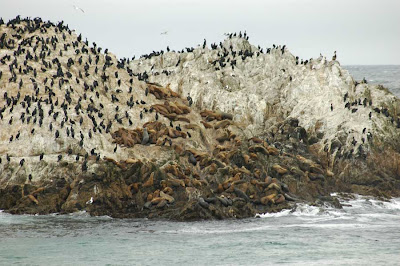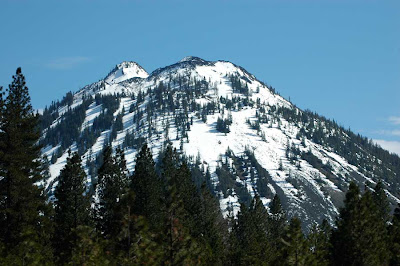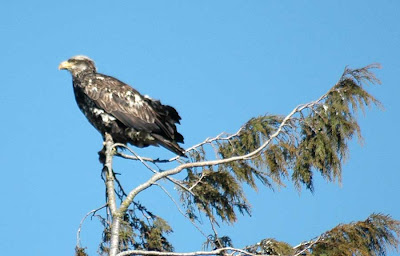Going through my trip photos one more time, I found a few other things I wanted to share that didn't quite fit into my other blog posts about the trip. The first is this beautiful marine mammal quilt that is on display at the Monterey Bay Aquarium. Click to see a larger version and admire each individual square. How cool would a blanket like this be to have?

Before the hockey game in San Jose (hard to believe that was a week ago today - it already seems so much longer ago!) we had time to explore the waterfront near Santa Cruz. This is the Santa Cruz Lighthouse - although there were no signs there that we could find telling us the name of it:

Right in front of the lighthouse that morning they were having a kayak surfing competition. It was a pretty calm day, but as waves come around the point where the lighthouse was perched, they would swell up enough for kayakers to ride them to shore. Quite different from the sea kayaking we see up here in the San Juans!

Just a little further north on the coastline we found they Seymour Discovery Center at Long Marine Laboratory, part of the marine sciences program at UC Santa Cruz. In the gift shop just outside of the exhibit hall I was surprised but pleased to find a few copies of my book on sale! We didn't have time to tour the exhibits but just outside was an impressive blue whale skeleton, which dwarfed the gray whale skeleton that was nearby. The building in the background is part of a desalination test plant, where they are experimenting with turning sea water into fresh water.

One evening while bird-watching we pulled over at Moss Landing State Beach, and were surprised to find a raft of sea otters - we counted about two dozen of them! Apparently it is common for them to congregate like this in a resting group even though they are often solitary, and it was dusk so they were probably getting ready to settle down for the night. Some of them were still feeding, which attracted all the gulls to the area as well. What I couldn't explain was the behavior many of them were exhibiting by covering their noses with their paws. I haven't been able to find out why they do this - maybe just to keep their noses warm?

Monday and Tuesday I will be attending the Transboundary Workshop for Marine Naturalists at Port Townsend, WA, which will be an event with extensive coverage on everything related to the Southern Resident killer whales and current research. There should be some interesting things to report afterwards.
I will also be giving a shore presentation introducing the Salish Sea Association of Marine Naturalists (SSAMN - pronounced "salmon") - a new group I've been a part of forming with a few other commitemed individuals. Our main goals are to network naturalists across the region, legitimize the naturalist profession, share educational opportunities, and work to provide accurate information about the local ecosystem that will help drive both residents and visitors to increased stewardship. A group of us started meeting in fall 2007 to form this group, and we opened for membership last November, but this will be a bigger announcement to really explain to a larger audience what we're about. If you are a naturalist in the Salish Sea region, hopefully I will see you there, or let me know if you want more information!
I will also be giving a shore presentation introducing the Salish Sea Association of Marine Naturalists (SSAMN - pronounced "salmon") - a new group I've been a part of forming with a few other commitemed individuals. Our main goals are to network naturalists across the region, legitimize the naturalist profession, share educational opportunities, and work to provide accurate information about the local ecosystem that will help drive both residents and visitors to increased stewardship. A group of us started meeting in fall 2007 to form this group, and we opened for membership last November, but this will be a bigger announcement to really explain to a larger audience what we're about. If you are a naturalist in the Salish Sea region, hopefully I will see you there, or let me know if you want more information!













































